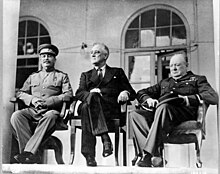Uni Soviet pada Perang Dunia II



Uni Soviet menandatangani sebuah pakta non-agresi dengan Jerman Nazi pada 23 Agustus 1939. Selain stipulasi non-agresi, traktat tersebut meliputi protokol rahasia yang membagi teritorial-teritorial Rumania, Polandia, Lithuania, Latvia, Estonia, Belarus, Ukraina, dan Finlandia ke dalam "lingkup pengaruh" Soviet dan Jerman, mengantisipasi "rearansemen teritorial dan politik" potensial dari negara-negara tersebut.[1] Joseph Stalin dan Adolf Hitler kemudian mendagangkan proporsal-proporsal setelah masuknya Soviet ke Pakta Blok Poros.
Catatan
sunting- ^ "chathamhouse.org, 2011". Diarsipkan dari versi asli tanggal 2015-12-08. Diakses tanggal 2018-01-03.
Referensi
sunting- Brackman, Roman (2001), The Secret File of Joseph Stalin: A Hidden Life, Frank Cass Publishers, ISBN 0-7146-5050-1
- Brent, Jonathan; Naumov, Vladimir (2004), Stalin's Last Crime: The Plot Against the Jewish Doctors, 1948–1953, HarperCollins, ISBN 0-06-093310-0
- Henig, Ruth Beatrice (2005), The Origins of the Second World War, 1933–41, Routledge, ISBN 0-415-33262-1
- Lewkowicz Nicolas, The German Question and the Origins of the Cold War (IPOC, Milan) (2008) ISBN 8895145275
- Merridale, Catherine (2007). Ivan's War: Life and Death in the Red Army, 1939–1945. Macmillan. ISBN 978-0-312-42652-1.
- Murphy, David E. (2006), What Stalin Knew: The Enigma of Barbarossa, Yale University Press, ISBN 0-300-11981-X
- Nekrich, Aleksandr Moiseevich; Ulam, Adam Bruno; Freeze, Gregory L. (1997), Pariahs, Partners, Predators: German-Soviet Relations, 1922–1941, Columbia University Press, ISBN 0-231-10676-9
- Roberts, Geoffrey (2006), Stalin's Wars: From World War to Cold War, 1939–1953, Yale University Press, ISBN 0-300-11204-1
- Roberts, Geoffrey (2002), Stalin, the Pact with Nazi Germany, and the Origins of Postwar Soviet Diplomatic Historiography, 4 (4)
- Roberts, Geoffrey (1992), "The Soviet Decision for a Pact with Nazi Germany", Soviet Studies, 55 (2), JSTOR 152247
- Rottman, Gordon (2007), Soviet Rifleman 1941-1945, Osprey, ISBN 978-1846031274
- Soviet Information Bureau (1948), Falsifiers of History (Historical Survey), Moscow: Foreign Languages Publishing House, 272848
- Department of State (1948), Nazi-Soviet Relations, 1939–1941: Documents from the Archives of The German Foreign Office, Department of State
- Taubert, Fritz (2003), The Myth of Munich, Oldenbourg Wissenschaftsverlag, ISBN 3-486-56673-3
- Watson, Derek (2000), "Molotov's Apprenticeship in Foreign Policy: The Triple Alliance Negotiations in 1939", Europe-Asia Studies, 52 (4), JSTOR 153322
- Wettig, Gerhard (2008), Stalin and the Cold War in Europe, Rowman & Littlefield, ISBN 0-7425-5542-9
Dalam negeri
sunting- Abramov, Vladimir K. "Mordovia During the Second World War," Journal of Slavic Military Studies (2008) 21#2 pp 291–363.
- Annaorazov, Jumadurdy. "Turkmenistan during the Second World War," Journal of Slavic Military Studies (2012) 25#1 pp 53–64.
- Barber, John, and Mark Harrison. The Soviet Home Front: A Social and Economic History of the USSR in World War II, Longman, 1991.
- Berkhoff, Karel C. Harvest of Despair: Life and Death in Ukraine Under Nazi Rule. Harvard U. Press, 2004. 448 pp.
- Braithwaite, Rodric. Moscow 1941: A City and Its People at War (2006)
- Thurston, Robert W., and Bernd Bonwetsch (Eds). The People's War: Responses to World War II in the Soviet Union (2000)
- Dallin, Alexander. Odessa, 1941–1944: A Case Study of Soviet Territory under Foreign Rule. Portland: Int. Specialized Book Service, 1998. 296 pp.
- Ellmana, Michael, and S. Maksudovb. "Soviet deaths in the great patriotic war: A note," Europe-Asia Studies (1994) 46#4 pp 671–680 DOI:10.1080/09668139408412190
- Glantz, David M. (2001). The Siege of Leningrad, 1941–1944: 900 Days of Terror. Zenith. ISBN 978-0-7603-0941-4.[pranala nonaktif permanen]
- Hill, Alexander. "British Lend-Lease Aid and the Soviet War Effort, June 1941 – June 1942," Journal of Military History (2007) 71#3 pp 773–808.
- Overy, Richard. Russia's War: A History of the Soviet Effort: 1941–1945 (1998) 432pp excerpt and txt search
- Reese, Roger R. "Motivations to Serve: The Soviet Soldier in the Second World War," Journal of Slavic Military Studies (2007) 10#2 pp 263–282.
- Thurston, Robert W. & Bernd Bonwetsch (2000). The People's War: Responses to World War II in the Soviet Union. U. of Illinois Press. ISBN 978-0-252-02600-3.
- Vallin, Jacques; Meslé, France; Adamets, Serguei; and Pyrozhkov, Serhii. "A New Estimate of Ukrainian Population Losses During the Crises of the 1930s and 1940s." Population Studies (2002) 56(3): 249–264. JSTOR 3092980 Reports life expectancy at birth fell to a level as low as ten years for females and seven for males in 1933 and plateaued around 25 for females and 15 for males in the period 1941–44.
Sumber primer
sunting- Bidlack, Richard, and Nikita Lomagin, eds. The Leningrad Blockade, 1941–1944: A New Documentary History from the Soviet Archives. Yale U.P.
- Hill, Alexander, ed. The Great Patriotic War of the Soviet Union, 1941–45: A Documentary Reader (2011) 368pp
Wikimedia Commons memiliki media mengenai World War II.